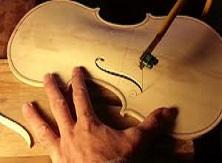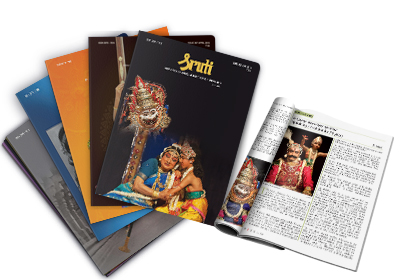
The violin is one of those instruments that has achieved a perfection in its construction. The hand sculpted violins of Antonio Stradivarius are not only perfect in their tone but the sculpting is of such a high quality that they can easily be compared to the sculptures of Michael Angelo.
The complicated design of the violin is responsible for the production of its unique tone. The violin consists of three units, namely, (a) the body which is the sound box, (b) the neck along with fingerboard, bridge, strings, tailpiece, and (c) the bow.
Its body acts as the sound box controlling the production of the sound sent in by the strings through the bridge. This sound gets modified depending on the quality and placement of its different parts. The top portion of the body is called the ‘belly’ or ‘top’. Quality violins are made of high class pine wood with very close grains which always run parallel from top to bottom. It has two ‘f’ shaped holes for sending out the sound which emanates from the body. At the center of the ‘f’ hole there are two ‘notches’ which indicate the position where the bridge has to be placed. It appears that the shape of the ‘f’ hole decides the combination of the higher and lower frequencies while letting out the sound from the inside of the body. A thin line of ebony is embedded into the belly parallel with its contour. It is called ‘purfling’ and enhances the quality of the vibrations.
The bottom of the body is called the ‘back’. It is made of maple or sycamore wood, the grains of which usually run across the body, that is, perpendicular to the grains on the belly. The violin-maker uses either a single piece of wood or two pieces joined together to prepare the belly and the back which are stuck together on either side of the ‘rib’ (the side walls). The rib is made out of six thin strips of maple, the grains of which run along the strip. The rib has two depressions towards the inside of the violin and they are called the C bouts. When the belly and the back are attached to the rib with a strong glue, it emerges with a beautiful shape.
Each part in the body affects the quality of the sound. The thickness and thinness of the belly and the back are important factors in preparing the violin. Different woods require different thickness. There is the ‘bass bar’ which is glued to the inside of the belly under the ‘G’ string (see illustration) which controls the volume of the lowest string ‘G’ and ‘D’ so that they do not over reverberate and drown the volume of the strings ‘A’ and ‘E’. The ‘sound post’ is a round piece of pine resembling a thin pencil which is kept just under the ‘A’ leg of the bridge. The grains of the sound post run along its length. The ends of the post are so shaped as to fit the curve of the belly and the back. The length is a crucial part in the preparation of the sound post. Posts of insufficient length will not capture the full volume of the sound vibrations and also fall down frequently. Posts which are longer could distort the quality of the sound and bend the belly which may result in a crack later on. The thickness and thinness of the sound post also have a say in the quality of the tone. For getting the best tone of the violin, the post should be placed in the exact location perpendicular to the plane of the back and belly.
The neck is made of maple wood. At the lower end of the neck is a beautiful piece of ornamentation called the ‘scroll’. The neck and the body are firmly glued together in a dovetail joint. It has a carved out hollow box called the ‘peg box’ having four holes in which the pegs are inserted. A fingerboard made of very hard ebony wood is glued to the top of the neck. The pegs are also made of ebony and are inserted in the peg holes to hold the strings tightly. There is a ‘finger board nut’ placed at the lower end of the finger board. It is slightly higher than the level of the finger board, may be by a millimeter or two, with depressions on it in which the strings can rest. If it is not fixed at the correct height or if it does not match the curve of the bridge, the violinist may find that some strings are too high requiring a lot of finger pressure or some are so low that they strike against the fingerboards and create a rasping sound.
The strings are passed over the bridge which conveys the sound to the belly and back. The bridge too is made of maple wood which is cut across the grains. It is made according to a traditional design which spreads the sound of the strings evenly throughout the body. It has two legs and if the contact of these legs with the belly is not perfect, the quality of the sound will not be good. It has some specially designed holes that help in distributing the sound. In new bridges, the feet are flat without any shape and they have to be shaped to fit the belly. There are also bridges with curved adjustable feet. The strings are tied to the holes in the tailpiece. Adjusters’ are used for fine tuning of the strings. The quality of the tailpiece determines the tonal quality of the violin. The tailpiece is tied with a gut or a wire to a peg (called the ‘end button’) on the top side of the body which fits into a hole in the rib. The gut or wire rests on a piece of ebony called the ‘saddle’ on the rib so that the tailpiece does not touch the body.
At every stage of manufacture the violin-maker checks the tone of the belly and back (by tapping) to ensure that their vibrations are according to a predetermined proportion. The violin is given the varnish at the final stage. While giving the final coat it is ensured that this proportion is maintained. A re-varnish of a violin can make or mar the tone of a violin. A label with the name of the violin-maker is pasted on the inside of the back of the violin near the position of the sound post.
The bow is usually made out of Pernambuco wood. Some have a peculiar grain resembling a winding snake. It is bent by heat to the required shape. An end of the bow is called the ‘tip’ which has a square hole into which one end of the bow hair is fitted and held in place tightly by a wedge. The other end of the hair is fitted to a ‘frog’ (a mechanism to control the tension of the hair) which is an oblong piece of wood with a curved surface on one side to fit the curvature of the bow. It has also a square hole into which the other end of the hair is fixed and secured with a wedge. The bow has an oblong hollow called ‘eyelet’ at its end and connects with a small hole at the tip of the bow (see illustration). A small nut with thread called ‘eyelet’ is fixed to the lower curved side of the frog. A long screw with a handle at one end called the ‘screw nut’, having the threads matching those of the nut, is inserted through the hole at the end of the bow and threaded into the nut. The frog then gets fixed to the bow and by turning the screw-nut the frog can move forward and backward along the bow, thus lowering and increasing the tension of the white horse hair. The quality of sound depends very much on the breed of the horse and country from which the hair originated. The hair has got minute projections which, when resin is added to it, make the string vibrate.
(The author is connected to a musical family and has studied the violin in a detailed manner.)


